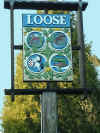|

The Village of Loose
Near Maidstone
I live on the out-skirts of a village called Loose, which is about two miles south from Maidstone, the county-town of Kent. The history of the village goes back to Saxon times when in the ninth century the manor of Loose was given by Ethelwulf, son of king Egbert, to a widow called Sueta. She in turn gave the land to the monks at Christ Church Priory in Canterbury.
The name of Loose (pronounced Looz) is Old English and means PIG-STY!
This (hopefully) was a reference to the chief occupation of the villagers, and NOT the state of the settlement!!
Running through the centre of the village is a small, clear river. It is called the River Loose and runs through the valley eventually becoming a tributary to the River Medway. This river was utilized by the occupants of the town to run a chain of water mills which were used to make paper. In fact one of these mills - Hayle Mill - still operates today.
In the village is a building called the Wool House. This is currently owned by the National Trust. It was constructed about 1850 and, as the name implies played some part in the production of wool, though exactly what is still not clear. According to the National Trust guide book the building was used for the cleaning of fleeces.
 The Wool House
Although Loose is situated along the main Maidstone to Hastings road thankfully it does not have to contend with the heavy stream of traffic which is often encountered in similar villages across the country. This is due to the impressive viaduct which was built in 1829 (14 years after the battle of Waterloo). The viaduct was designed by the great engineer Thomas Telford, and apart from a public footpath which was added in 1934 it has remained unaltered to this day.

Loose Viaduct

The
plaque showing the name of Thomas Telford
Of course the most frequented establishment in Loose is the pub. Although Loose is not particularly large it does have a number of pubs which offer a welcome break from the rigours of life. The best known of these is The Chequers Inn which is situated in the centre of the village and has an enchanting footpath running along side it which follows the path of the stream to the millpond.

The Chequers Pub
As you can see from the photo the pub is situated at the bottom of a steep hill (Loose Hill). In former years the publican owned a team of strong horses which could be hired to aid the advancement of heavy cargos up this hill.
The village contains a couple of Churches, All Saints Church being the more picturesque of the two. It was built sometime before 1300. Over the next few centuries additions were built onto the Church presumably to allow for a growth in the congregation. In 1878 the Nave was seriously damaged by fire. Records show the alarm was raised at 4:30 am on the 13th of January, and a message was sent to Maidstone for a fire engine. The fire engine arrived at 7 am, some three and a half hours
later!
The fire was finally extinguished at around 10 am.

All Saints Church, Loose Surrounding the Church is the village grave yard. The most notable feature of which is a large Yew tree which has a circumference of some thirty feet. Near to the Yew tree is the Charlton Pillar Memorial. Legend has it that if you stick a pin into the Yew tree and run round it anti-clockwise twelve times at midnight, then look into the small window above the memorial you will see a face.
 The Charlton Pillar Memorial Another, more macabre, story states that if you stick a pin in the tree and run round it twenty-four times, then stand on the table-tomb near to the Church porch and look through the trefoil window you will see a woman killing a young child. Whether or not this true I have yet to discover!

The Florence House
The above sketch is of Florence House. This building has been used as a number of different shops since its construction in the 18th century.
Now however it is used as a residence for one of the Loose villagers. It is interesting as it has the River Loose running along its side, and can only be entered via a stone bridge which crosses the fast flowing river.
Loose in relation to the United Kingdom
 This section of my web site owes a lot to Roger Thornburgh, and his book Exploring Loose Village, which is sadly no longer in print, but can be obtained from Maidstone Library.
|